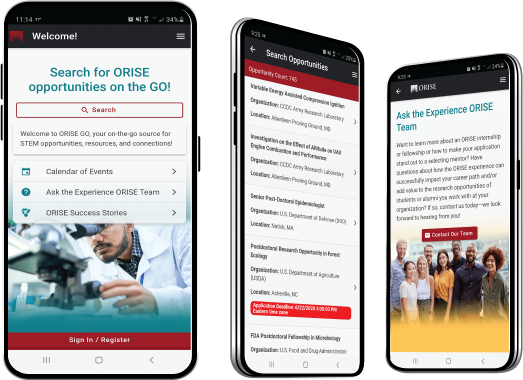Population mobility and pathogen transmission: validation of non-traditional approaches
Create and release your Profile on Zintellect – Postdoctoral applicants must create an account and complete a profile in the on-line application system. Please note: your resume/CV may not exceed 2 pages.
Complete your application – Enter the rest of the information required for the IC Postdoc Program Research Opportunity. The application itself contains detailed instructions for each one of these components: availability, citizenship, transcripts, dissertation abstract, publication and presentation plan, and information about your Research Advisor co-applicant.
Additional information about the IC Postdoctoral Research Fellowship Program is available on the program website located at: https://orise.orau.gov/icpostdoc/index.html.
If you have questions, send an email to ICPostdoc@orau.org. Please include the reference code for this opportunity in your email.
Research Topic Description, including Problem Statement:
- The complex networks of social interaction that comprise human societies are highly variable in space and time. Heterogeneity is driven by a combination of seasonally predictable events (e.g., religious migrations; patterns of tourism) and idiosyncratic phenomena (e.g., natural disasters; political upheaval).
- Epidemiologists have long appreciated the fundamental relationship between human mobility and infectious disease transmission. Patterns of social interaction influence transmission dynamics within a population, whereas the degree of connectivity between populations governs pathogen dispersal across geographic landscapes.
- Most traditional methods of estimating human migration (e.g., cross-border surveys; census data) lack the temporal resolution needed to investigate seasonal patterns of human mobility. Other methods either lack the spatial resolution necessary to quantify sub-regional travel (e.g., air traffic volume data) or require a degree of investment that can be difficult to scale (e.g., GPS data loggers; travel history surveys).
- The development of scalable approaches that leverage high-resolution data sources (e.g., remote-sensing technology, anonymized call data records, social media data) to estimate human travel on fine-grained timescales would enhance existing efforts to anticipate patterns of pathogen propagation across space and time.
- The purpose of this topic is to explore the relationship between temporal heterogeneity in human mobility and infectious disease transmission. To achieve this goal, there are three primary aims:
(A) Identify and validate a reliable predictor of short-term (i.e., weekly/monthly) travel patterns at the sub-regional scale (i.e., between intra-urban and intra-national resolution).
(B) Evaluate the relationship between this travel proxy and infectious disease transmission.
(C) Explore the extent to which down-sampling of the spatial and temporal resolution of the proposed travel proxy influences the observed relationship with infectious disease transmission.
Approaches:
- Research proposals may draw from a wide range of academic disciplines (e.g., molecular epidemiology, population genetics, social network theory, etc.), but all proposals are encouraged to adhere to a hypothesis-driven framework. Also, proposed epidemiological relationships should be validated using empirical data. Accordingly, proposals are encouraged to identify a model system (i.e., infectious agent; geographic region), data repository (e.g., influenza incidence data from CDC FluView; nucleotide sequence data from NCBI Genbank), and proposed travel proxy (e.g., satellite nightlights; anonymized call data records) that will allow for empirical investigation.
- The following examples highlight a few potential avenues for future inquiry. However, it should be noted that proposals are not limited to these questions and novel research foci are highly welcomed.
Example 1: Satellite imagery of nighttime light intensity and virus transmission.
- Previous research has highlighted a relationship between the population size/density of urban centers and satellite-derived measures of nighttime light intensity. Social gravity models are commonly used to infer the volume of migration between a pair of populations by assuming that travel is a function of population size and geographic proximity. For a region of interest, evaluate the relationship between spatiotemporal variation in nighttime light intensity and seasonal variation in viral transmission.
- Potentially relevant considerations:
(A) Is the temporal variability of nighttime light intensity of sufficient resolution to capture short-term population movements? What independent data sources would allow for validation of this proxy?
(B) Is a social gravity model sufficient for inference of the magnitude of inter-population travel?
(C) Does this travel proxy predict heterogeneity in viral transmission? How robust is this relationship to the temporal resolution of inferred travel estimates?
(D) Do other seasonal variables (e.g., ambient temperature) better explain this epidemiological relationship?
Example 2: Parasite population structure and social network connectivity.
- Human-mediated dispersal offers opportunities for recombination between parasite populations that would otherwise be distantly separated, potentially giving rise to novel genetic backgrounds. The capacity to identify where and when these recombination hotspots arise holds important implications for the evolution of drug resistance and would enable public health interventions to prioritize control measures appropriately. Evaluate whether seasonal variation in measures of social connectivity (e.g., derived from anonymized social media data or call data records) is associated with dynamic fluctuations in the population structure or genetic diversity of parasites within and among sampling locations.
- Potentially relevant considerations:
(A) Which, if any, network parameters (e.g., degree; eigenvector centrality) are most predictive of parasite population structure and genetic diversity? Has the parasite population been subjected to control measures that could independently influence population structure?
(B) Is parasite population structure responsive to seasonal variation in human population flux, or has the parasite population achieved equilibrium?
(C) To what extent are these relationships robust to the temporal resolution of sampling?
Relevance to the Intelligence Community:
- In this globally interconnected society, infectious diseases that were once geographically isolated now pose a tangible threat of global emergence. During the last decade, pathogens ranging from swine flu to the Ebola virus have elicited widespread mortality and morbidity, strained healthcare systems, and threatened to destabilize modern society by inflicting billions of dollars in economic damage. The capacity to retrospectively quantify and proactively anticipate temporally heterogeneous patterns of human population movement would enable epidemiologists to predict routes of disease propagation and facilitate the efficient allocation of resources during periods of predicted outbreak risk.
- The capacity to quantify and anticipate human population movements on short-term timescales is a critical need that transcends infectious disease modeling. The manner by which populations respond to political turmoil, natural disasters, or even trends in tourism have important implications for a wide array of national security interests ranging from terrorism to food security. Accordingly, proposals that address this topic appeal to a broad swath of the intelligence community.
Key Words: Infectious disease; epidemiology; social network theory; human behavior; molecular biology; population genetics; population dynamics; short-term population mobility; statistical modelling
Postdoc Eligibility
- U.S. citizens only
- Ph.D. in a relevant field must be completed before beginning the appointment and within five years of the application deadline
- Proposal must be associated with an accredited U.S. university, college, or U.S. government laboratory
- Eligible candidates may only receive one award from the IC Postdoctoral Research Fellowship Program.
Research Advisor Eligibility
- Must be an employee of an accredited U.S. university, college or U.S. government laboratory
- Are not required to be U.S. citizens
- Citizenship: U.S. Citizen Only
- Degree: Doctoral Degree.
-
Discipline(s):
- Chemistry and Materials Sciences (12 )
- Communications and Graphics Design (6 )
- Computer, Information, and Data Sciences (16 )
- Earth and Geosciences (21 )
- Engineering (27 )
- Environmental and Marine Sciences (14 )
- Life Health and Medical Sciences (45 )
- Mathematics and Statistics (10 )
- Other Non-Science & Engineering (5 )
- Physics (16 )
- Science & Engineering-related (1 )
- Social and Behavioral Sciences (28 )

 ORISE GO
ORISE GO

The ORISE GO mobile app helps you stay engaged, connected and informed during your ORISE experience – from application, to offer, through your appointment and even as an ORISE alum!





